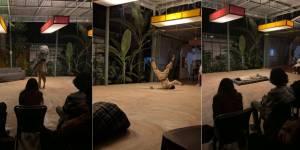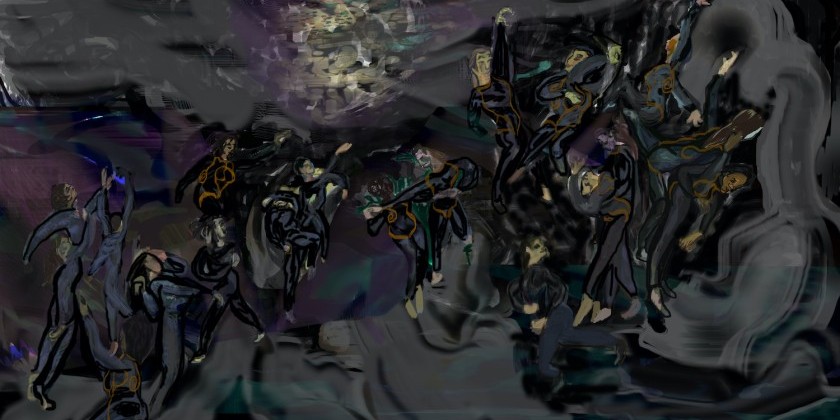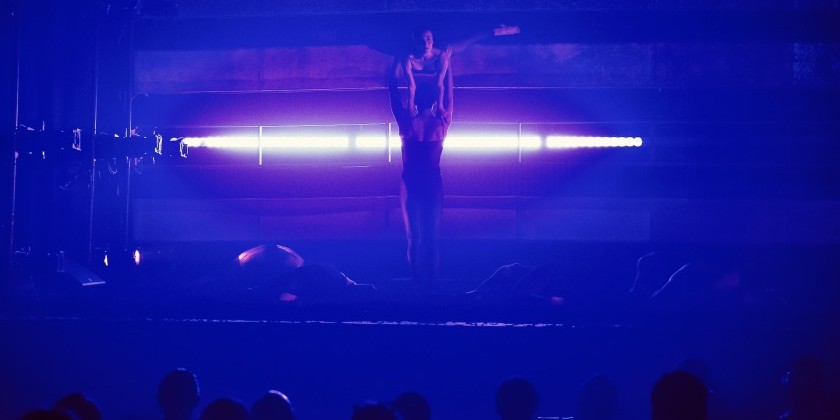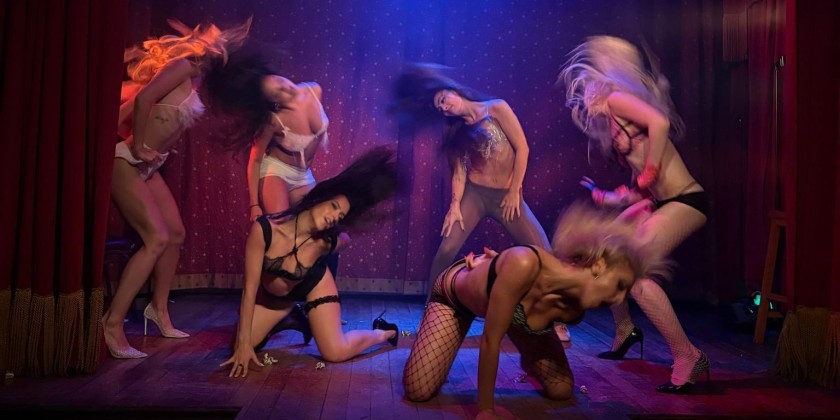AUDIENCE REVIEW: "Here We Root" by Jiemin Yang
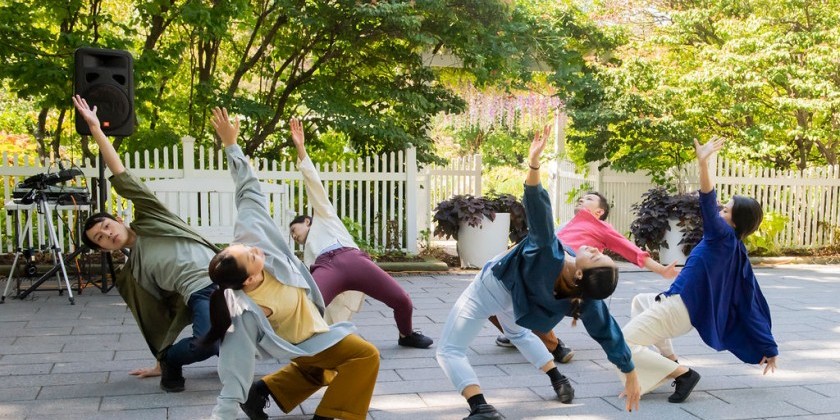
Company:
Jiemin Yang
Performance Date:
October 8, 2022
Freeform Review:
Here We Root is an outdoor contemporary dance work by Jiemin Yang that shares the stories of Asian immigrants, focusing on the Chinese diaspora in Flushing, NY. Here We Root premiered on October 8, 2022 at the Queens Botanical Garden in Flushing, NY. The piece combines text, theatre, dance, and an original musical score to create the most vivid, truthful investigation of the realities of living in Flushing, NY as an Asian immigrant.
Mayu Yamashita opened Here We Root with a charming, inviting solo. She danced to a spoken voice recording, with voice by actress Chun Cho. The recording introduced the idea of sharing stories about her character (who is a Chinese immigrant who moved to the United States) and her neighbors. Mayu danced in timing with the words, transcribing the word’s meaning with her body, but adding layers of spark and unpredictability. Her presence was open.
At the end of Mayu’s solo, she began a falling sequence which initiated the rest of the Here We Root cast to join her in the space. Joining her was Tsubasa Nishioka, Maya Lam, Eric Hang-Yu Liu, and Kathy Chen. Each dancer wore long pants, a loose, open collared shirt, and an undershirt in various pastel colors. The costumes’ color scheme was bright, and a pleasurable contrast against the green garden. While in the space, the audience heard a list of reasons why Mayu’s character and her neighbors had decided to move to Flushing: “Some are here for their family…their children’s futures…their freedom…or escape. Some are here for a new lifestyle… for education…for their dreams…for adventures.”
The dancers began a unison sequence; their movement was tense, intricate, and repetitive. They moved to a new voice recording which was layered with fast-paced music composed by James Acampora. This voice recording spoke of the difficulties of moving to a new country with a completely different language and culture – and how it can then be hard to connect with people. Other difficulties included being away from family, and how it is difficult to work when one is not allowed to do anything other than what their visa states they are in the country for. The dancers maintained a steady, driving pulse in their fast movements. They shook their bodies, wrung their hands, and executed fast walking patterns. Tsubasa Nishoka had a beautiful breakout moment where he danced alone - his character released so much emotion in tandem with the voiceover. He was extremely vulnerable as he released hard-hitting throws, rolls and jumps before rejoining the group.
Dissolving into a new solo, Maya Lam dances to the music of Erhu (a Chinese two-stringed instrument), played by Danting Qiao and composed by James Acampora. Maya offers an undulating gesture at the beginning of her dance, which is calming. A charming duet by Mayu Yamashita and Eric Hang-yu Liu follows. They smile at one another as they danced, which were some of the first smiles within the first nine minutes of the dance. They partnered, often repeating an image where they held onto one another’s shoulders, leaned back, and threw a front attitude to the sky. A back attitude followed. As they danced, I could hear, “Life here [in America] is more colorful, interesting, and exciting.”
Tsubasa Nishioka enters the space with the piece taking a darker atmosphere, highlighting difficulties of getting a visa approval. “Seeing their family is their only dream. They have no choice but to work. A piece of paper [the visa] can define a person’s destiny…” Tsubasa mimicked opening and reading the pages of a book, when the visa was being described. At times felt like the gestures were too literal with what the voiceover was saying, but it did make the story accessible to follow.
There is a moment where the dancers - except for Shan Y. Chuang - joins together in a circle, swaying, after the voice recording describes the community she found when moving to Flushing. Flushing has a huge hub of superb Chinese restaurants. The food is so authentic that people travel from other states to enjoy it. Enjoying meals with friends who were in similar situations allowed the narrator to feel more at home in Flushing.
The circle is disrupted when Shan Y. Chuang enters the circle asking, “Excuse me?” over and over. She played a character who used to live in Flushing but has moved away to Virginia. This character introduced a new dynamic because the spoken word was live — she was an actress. Her character drove eight hours from Virginia back to Flushing to meet friends for a meal. The character emphasizes how boring Virginia is, where it’s hard to come across a person on the street, and how much she misses good Chinese food. A moment I enjoyed was when she asks the audience what she should eat while in Flushing: answers included dim sum, rice noodles, and hot pot. Chuang incorporates Chinese language in her monologue, as well as gestural movements. She walks around the space as she speaks and encompasses the entire stage with her love for Flushing.
The friends she was meeting for dinner are the dancers, who rejoin her in the space. Together they dance, describing with their bodies how they prepare and enjoy delicious Chinese meals together. They incorporated gestures of mixing, chopping, stirring, throwing their hands in the air (perhaps with joy?), and simply eating. Mayu Yamashita was particularly virtuosic in this section, as she really threw herself into the movements.
Following the group’s unison, a story of discrimination was told by Maya Lam and Mayu Yamashita. Maya Lam spoke while they moved, and she described a man aggressively yelling at her to go back to her country. The story took place at the beginning of the COVID-19 pandemic. Maya’s character stood her ground, and told the man – portrayed by Mayu Yamashita – to leave her alone. Mayu Yamashita made the move to punch her - but “being agile and trained in martial arts,” Maya Lam’s character blocked him. It was a sobering reminder of how difficult the pandemic remains for AAPI immigrants, on top of an already difficult situation of job loss within the arts. “Worse things [than my story] have happened to many other Asians,” Maya Lam concluded, before exiting the space.
Tsubasa Nishioka, Kathy Chen, and Eric Hang-Yu Liu walk into a triangular formation and begin swaying to dark, tense music composed by James Acampora. They repeatedly descend to the ground, roll, and pick themselves up again. They throw their bodies into fast pivots, they toss their legs, and they move together as one unit. The knocking down and standing up reflects the hurtful words and actions from Maya Lam’s story in the previous scene. No matter how often racists attempt to exclude, the AAPI community unequivocally belongs here. Tsubasa, Kathy, and Eric conclude their trio by standing in a straight line in a wide stance, staring out into the audience with confidence and strength.
The dance concludes on an optimistic note; the group rejoins together, and they dance a final unison. The final voice recording describes that they share a common goal of creating a new life in America. They are “like dandelions [who blossom], and adapt – here, they root.”
Author:
Kristen Hedberg
Website:
kristenhedberg.org
Photo Credit:
Hisae Aihara




